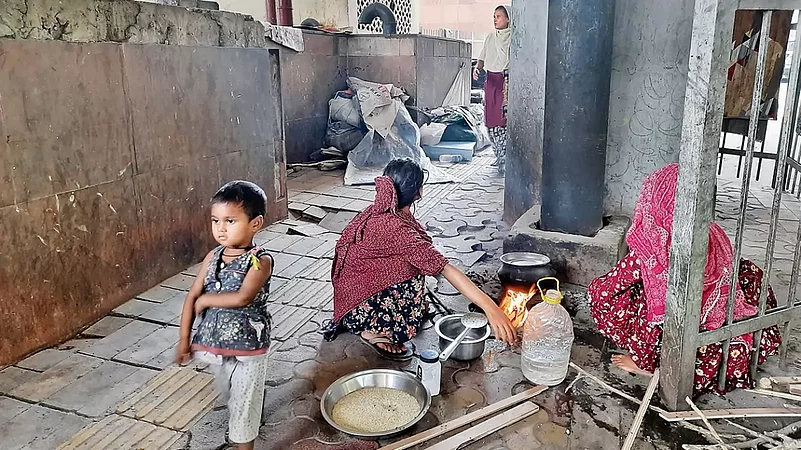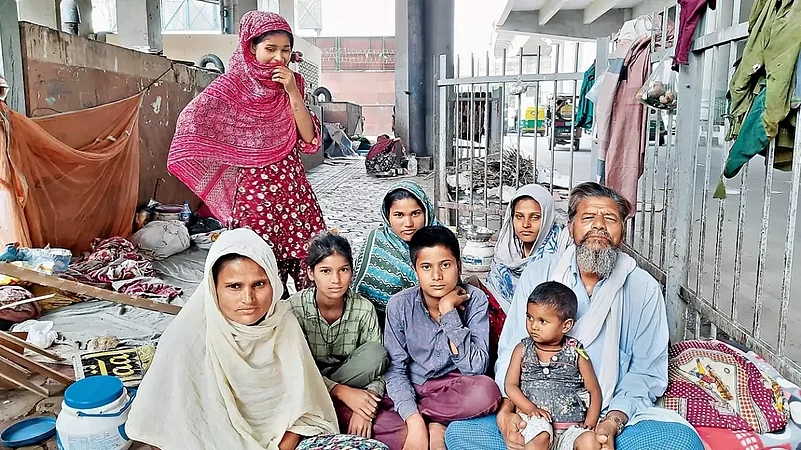Sitting on the pavement that doubles up as a makeshift shelter near Jasola, Rukhsana (name changed), pulls her four-year-old close.
“This is our fourth child and all of her brothers and sisters will make sure that she gets a good education,” she says.
When asked if she has ever heard of population growth and its concerns, she says that back in her village in Bihar, people used to talk about “Hum do Humare do” (‘Us two and our two’). “But such things are for those who stay in flats,” adds Rukhsana, who, in her early 40s, works as a domestic worker in seven houses with two of her teenaged daughters also having joined her line of work. Her husband pulls a rickshaw on a contract basis while her eldest son works in a shop nearby. Four earning members of the family, she believes, would ensure that the youngest doesn’t suffer. For Rukhsana, her children are an asset, not a liability.
The Indian state’s policies on population tell a different story. The presumption that poor people contribute more to the growth of the population and thus take up a larger share of natural resources is so embedded that several efforts have been made by consecutive Indian governments to target the lower classes. From Indira Gandhi’s forced sterilisation in 1976 of reportedly 6.2 million people in a year to 30 private member bills related to population control — both lapsed and pending, policies on controlling population have been directed at poor people. The latest ‘Population Control Bill’ tabled by Rajya Sabha MP Rakesh Sinha in July 2019 also suggested reduced access to the Public Distribution System (PDS) as a penal measure, if people didn’t adhere to the two-children norm.
As per the NITI Aayog’s Multidimensional Poverty Index (MPI) of 2021, Bihar (51.91 per cent), Jharkhand (42.16 per cent), and UP (37.79 per cent) are the poorest states across different trajectories while two of them —Bihar and UP— also top the list in terms of population growth with extensive population densities of 1,106 and 860 per square km, respectively.
At a time when Prime Minister Narendra Modi, while flagging apprehensions about ‘population explosion,’ during his Independence Day speech in 2019, lauded those who followed the “small family policy” for “being patriotic”, this correlation between poverty and population needs to be urgently examined.
The Myth Of Malthus
In 1798, English economist Thomas Malthus famously proposed that an increase in food production would cause an initial spike in population that would then result in depleted food resources, poverty, and a consequent decrease in population. Referring to such deaths as “readjustment mechanisms”, Malthus argued that they would naturally play their role if the land failed to feed several mouths.
The Malthusian theory was so widely accepted at the time that the British government, in the aftermath of the Irish famine during 1845-1852, considered the deaths of 10 lakh people as a process of natural readjustment.

The narrative of this so-called ‘Malthusian check’ echoed at the 1994 International Conference on Population and Development (ICPD) in Cairo. Their programme of action declared that population growth influenced poverty and thus “efforts to slow down population growth, to reduce poverty, and to achieve economic progress are mutually reinforcing”. The United Nations, in its 1997 Human Development Report, also noted that poverty reduction was closely linked with slower population growth.
On the contrary, the consultative meeting of the U.N. Population Fund, as far back as 1992, pointed out, “Research has not established a strong causal link running from high fertility to poverty.” World Bank economist Lant Pritchett also clearly noted the paucity of evidence needed to prove the poverty-population nexus. Nevertheless, the idea that the poor are responsible for the depletion of natural resources because of their supposed contribution to population growth still echoes to this day in the corridors of power.
The Fertility-Literacy Connection
Poonam Muttreja, the Executive Director of the Population Foundation of India, debunks the prevalent narrative of the poverty-population nexus and focuses, instead, on the literacy of women and its relation to their fertility and agency in marriage and family planning.
“According to the National Family Health Survey 5 of 2021 (NFHS-5), mothers with no schooling had a total fertility rate (TFR—defined as the average number of children born to a woman during her lifetime) of 2.8, as against a TFR of 1.9 reported by mothers who had completed at least 10 years of schooling,” says Muttreja.
In terms of the sources of poverty, the World Inequality Report, 2022, shows that 60 per cent of wealth is concentrated in the hands of 10 per cent of the global population.
The data also shows that only 41 per cent of women aged 15-49 had completed 10 years of education and for rural India, it is just a little more than one-third. According to Muttreja, socio-economic status and societal norms play a major role in fertility behaviour, whereby women’s educational and economic status influence, to a great extent, the degree of autonomy they have in decisions regarding marriage and family planning.
It is important to note that while India’s absolute population has risen over the decades, there has been a simultaneous reduction in both the rate of population growth as well as of multidimensional poverty. According to the 2011 census, the population growth rate of India has dipped down to 17.7 per cent from 21.5 per cent in 2001. The reports of the United Nations Development Programme (UNDP) note that multidimensional poverty in India has also dropped from 55.1 per cent in 2005-06 to 16.4 per cent in 2019-2021.
Similar evidence could be found across the world as well. In 2017, Guatemala’s birth rate stood at 2.9 —the highest among the Latin American countries— a drop from 5.5 in 1989. Several studies attribute this fall to the decline in poverty. In Cambodia, most families had, on an average, six children in 1994, a number that fell almost 40 per cent in 2015 due to the country’s growth in per capita income.
At first glance, this data may indicate a causation between poverty and population growth but there is more to the phenomenon than meets the eye, apart from the Malthusian notion that the poor procreate more, especially in cases like Rukhsana’s, where a host of dynamics are involved.
Necessity Of Wealth Redistribution
According to Sanghmitra Sheel Acharya, the Chairperson of the Centre of Social Medicine and Community Health, Jawaharlal Nehru University, an economic frame is needed to understand the complexities behind the motive to procreate, where every child contributes to the economic growth and sustenance of the family.
“But gradually the aspirations of people are changing. If one looks at the NHFS-5 data, one can see that the TFR in Odisha has come down almost near to that of Kerala or Goa despite having significant undernourishment and poverty,” Acharya notes.
While India’s population has risen over the decades, there has been a simultaneous reduction in both the rate of population growth as well as of multidimensional poverty.
In terms of the sources of poverty, the World Inequality Report, 2022, shows that 60 per cent of wealth is concentrated in the hands of 10 per cent of the global population. Different global estimates also note that in the last 25 years, the wealthiest 10 per cent have contributed to more than half of the total carbon emissions, indicative of how the wealthiest are more implicated in the use of natural resources, not the poor. However, Muttreja points out that as per the global projections of the United Nations’ International Resources Panel, less than one-third of the anticipated increase in the use of natural resources till 2050 would be the result of population growth. There is, therefore, a need for more evidence-based studies that can effectively demonstrate the link between population growth and the depletion of natural resources.
The NFHS-5 data also show that women across the country want very few children. The desired fertility rate among women of 15-49 years age is 1.6, lower than the current TFR of 2.0. Referring to the decline of the fertility rate, renowned economist Jean Drèze says, “Population growth will continue for some time but at a declining rate, and it will turn negative within a few decades.”
Drèze also opposed coercive measures to control population growth.
“Coercive measures to reduce population growth are likely to be counter-productive, and they are objectionable in any case. Instead, we should focus on constructive measures such as women’s empowerment and better access to school education, healthcare, and contraceptive methods,” he adds.
People like Rukhsana, therefore, need such guarantees to a dignified life so that the lives of their young don’t depend on their teenage siblings working as domestic workers in the houses of the wealthy.
______________________________________________________________________________________________
This appeared in print as "The Poverty-Population Myth"

















